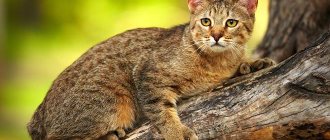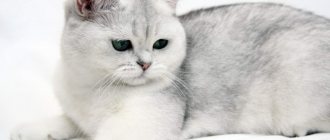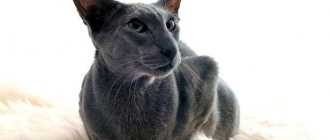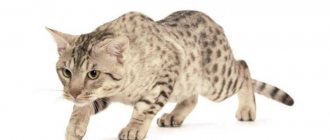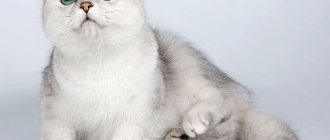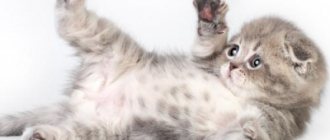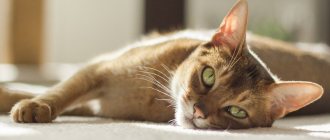Origin of the breed
The Aegean cat is native to Greece.
The Aegean cat got its name from its origins in the Aegean Islands of Greece.
The Aegean cat breed developed naturally, without human intervention, and was domesticated several centuries ago.
In Greece and Turkey, this breed of cat still lives on the streets and is considered a wild animal – it likes to stroll around the territory of fishing ports and catch prey. However, the Greeks value the Aegean breed and consider them a national treasure, since the hunting nature of the animal helps fight rodents, preserve the catch and harvest.
A business relationship developed between people and cats, according to which fishermen fed the cats fish, and they rid them of pests. Therefore, this breed easily establishes contact with people and treats them with trust and devotion. She is also a lover of water treatments and fish.
Aegean predators began to be bred as domestic cats at the end of the 20th century. However, as an Aegean breed, these cats are not identified by the felinological service and they do not have specific standards. The Wikipedia website gives a fairly brief description of the Aegean cat breed, without specifying breed standards.
In Russia they are not popular because of their external resemblance to ordinary yard cats. If you take a photo of an ordinary Murka and an Aegean cat, it is not a fact that there will be significant differences.
Interesting : Archaeologists have found evidence of the presence of the Aegean cat breed in Cyprus about 10 thousand years ago.
How to choose a kitten?
Many people want to have a tricolor kitten in their home. You should choose it in the same way as a pet of any other natural color. You must like the baby. Ideally, your sympathies should be mutual. Only in this case can we talk about a comfortable and pleasant coexistence of you and your pet in the same territory.
It is equally important to ensure that the baby, like his parents, are strong and healthy enough. Their nervous system should not have flaws and shortcomings
Raising a pet should also be good - this is the criterion that will prevent you from encountering many common problems later.
It is advisable to purchase from reliable breeders, especially if you are choosing a purebred baby.
The Norwegian Forest Cat is another gorgeous breed that can be born tri-colored. These pets have a kind and friendly disposition. In addition, their strengths are excellent intelligence, courage and playfulness. A healthy Norwegian cat can easily find a common language with the owner and other animals in the house.
Norwegian cats are also particularly inquisitive. They love to spend their days looking out the window at the birds or exploring in detail what is happening on the highest cabinets in the house. As for the attitude towards strangers, the Norwegian cat demonstrates coldness and restraint. He will not run and sit in the arms of your guests, especially if the pet sees them for the first time.
In order for a cat of this breed to begin to trust a person, it is necessary to spend a lot of free time. However, a healthy and active pet can easily find a common language not only with one, but with all members of the household.
The main feature of the representatives of the described breed is that they do not like to be cuddled or cuddled with. The ideal demonstration of your love in this case would be if you pet the cat or scratch it in its favorite places. Perhaps after some time the Norwegian cat will allow you to sit on your lap, but no one will definitely give you such guarantees.
This pet is not afraid of sudden changes in environment, unlike most other types of cats and cats.
But if a small three-color miracle came to your door on its own or came to you on the street, then you should not drive it away under any circumstances, because such an event is considered a very good sign. If you pick up such an interesting baby on the street, then you should immediately take him to the veterinarian. The animal will be examined there. If necessary, the kitten will be treated at the veterinarian's office.
If you are selecting a kitten for subsequent participation in exhibitions, but you just need to familiarize yourself with its pedigree
It is equally important to make sure that the baby you choose meets all the stated standards that apply to representatives of a certain breed
It is also important to ensure that the baby’s ears are clean, as are his eyes. The fur should also be in perfect condition.
A healthy baby's breathing will always be smooth. The gums should be soft pink. There should be no redness or inflammation in the mouth.
Never remain silent if you have any questions about the kitten you choose. This is especially true in cases where an expensive purebred baby is selected. You can also consult the breeder about the specifics of keeping a kitten of a certain breed.
Appearance
The Aegean cat is similar to ordinary yard cats
Aegean cats and cats have standard sizes and do not have any striking external features. The appearance of the animal resembles an ordinary yard cat.
Anatomical features
Despite the similarity of the animal with ordinary cats, the Aegean breed still has its own general standards, a description of which is given in the table:
| Weight | Adult males reach a weight of 4-5 kg. Females – 2-4 kg |
| Torso | Medium size with well-developed muscles, with a wide chest |
| Head | The head is widened towards the occipital part, triangular in shape with an elongated nose, smoothed cheekbones |
| Neck | Powerful, almost on the same level as the head |
| Paws | Medium size, strong and powerful, the pads are round in shape with strong and long hunter claws |
| Tail | Straight, long, powerful at the base, tapering towards the tip |
| Ears | The ears are triangular, straight, standard size, set apart, covered with hairs |
| Nose | The nose is elongated, straight |
| Eyes | Oval shaped in various colors: green, yellow and blue. The eyes are bright and shining. Most often the eye color matches the coat color |
The structural features of the animal's body, the development of its muscles and the strength of its paws make Aegean cats outstanding hunters, energetic and playful. Such a pet will not be lost on the street.
Coat and color
Aegean tricolor cat
The body of Aegean cats is covered with medium-length hair. The hairs are straight, the coat is shiny, smooth, thick, there is no undercoat. Wool has water-repellent properties.
The fur coat of these predators is a combination of two or three colors. The main color is always white and should occupy 2/3 of all colors. On the paws, muzzle, tail, chest and parts of the body, colors such as red, black, gray, cream and shades of brown can be combined.
In photographs on the Internet or in the yard you can see the familiar three-color color scheme: black, red, white. However, the Aegean tricolor cat can also have the same coloring, when black and red (cream) fur lies in spots on the white coat. This color is one of the most common. This coloring is not always characteristic of the Aegean breed. Ordinary domestic cats also have a tricolor color.
Interesting: the Aegean cat breed does not have any distinctive external characteristics and can easily be confused with a barn cat.
Exterior
The climate has hardened this breed in terms of endurance and survival with a small amount of food, so the size of these seals is quite small. The weight of a sexually mature individual is in the range of 2-4 kilos, females are not much smaller than males.
In general, Aegean cats stand out for their perfect features and vitality. Genetically determined diseases are not observed. Since the official standard has not been approved, the characteristics are based on the appearance of the murkas living on the streets of Greece:
- The body is strong, sinewy, with well-developed muscles.
- The neck is not particularly long, powerful, but flexible.
- The shoulder girdle and sternum are quite extensive.
- The limbs are strong, in harmony with the torso.
- The claws are large and curved, especially on the hind legs.
- The tail is in harmony with the body, but the fur on it is much more luxurious.
- The head resembles a regular triangle with graceful features.
- The nose is consistent in size, expanding from the tip to the bridge of the nose.
- The eyes are wide open, reminiscent of almonds, with eyeliner. The gaze is thoughtful and significant.
- The ears are long, rounded, set at a great distance and look slightly to the sides. The ears are almost entirely draped with fur sticking out to the sides.
Interestingly, living in a harsh natural environment causes Aegean cats to have lightning-fast reactions. Ear hairs help the senses. By moving its ears, the animal detects the movement of air currents and the range of sounds.
The fur of Aegean cats is short, dense, and has no undercoat at all. The range of colors of these creatures is diverse, but there is one nuance: the background color is invariably perfectly snow-white.
The other color of a two-color suit can be absolutely anything: black, silver, blue, red, peach, fiery, chocolate, gray. This is also true of the point pattern, which comes in stripes, ticking and solid markings.
It should be noted that if an all-white Aegean has a broken tail, hereditary problems with the eyes and ears, an awkward structure, or too weak paws, then such an individual is rejected from the selection process and subjected to sterilization.
Character of Aegean cats
Aegean cats and cats are willful and independent, but loyal and obedient
It so happened evolutionarily that the Aegean cat breed cannot sit still. They are active, playful, have a perky and cheerful disposition.
When choosing an Aegean cat as a pet, you should familiarize yourself with the following habits, habits and characteristics:
- Activity . Keeping a pet of this breed locked up and ignoring the games will not work. These are freedom-loving animals that need to splash out their energy and move.
- Friendliness . Despite their wild disposition, these cats find a great way to get along with people, quickly become attached to them, treat them with trust and recognize their owner. However, this does not prevent them from treating other family members kindly. They themselves are the first to easily make contact, are not aggressive and do not have conflicts.
- Learning ability . Cats and cats easily learn the daily routine of their owner, are not intrusive and treat criticism courteously. They quickly become toilet trained. By slightly raising their voice or changing their tone, accompanied by a menacing gesture, the Aegean will quickly understand where they were wrong and stop the pranks. But they do not forgive violence and will not allow themselves to be offended.
- Hunters . The Aegean can easily cope with small rodents or catch a bird on the street, which makes it dangerous for other small pets in the house. A hamster, parrot or aquarium fish can become dinner or elements of a predator's game.
- Defenders . A pet of the Aegean breed, having recognized the owner and members of his family, will protect even its smallest representatives and will never respond to the child with aggression.
The cat will happily go with its owner for a walk or fishing and will patiently wait for the catch.
It’s interesting: despite their activity, they don’t tend to play dirty tricks and damage furniture and things in the house, so you can rely on such a pet and not expect any trouble from it.
Walks
If your Greek cat does not have the opportunity to walk outside, then the owner needs to accustom him to a harness and take him for walks every day, since these cats especially need a promenade. In general, Aegean mustaches need space, and in a small one-room apartment they will be very uncomfortable.
Care and maintenance of the Aegean cat breed
Aegeans are not prone to chronic diseases, but need care and concern
Considering that the Aegean breed formed on its own without the intervention of breeders, they have excellent health and the absence of diseases at the genetic level. But since the animal, as a rule, spends a lot of time outside, is extremely active and eats rodents and birds, it can receive various eye injuries, digestive system disorders, fleas, and ticks. Therefore, the condition and behavior of the animal must be monitored.
Recommended:
- Brush the animal's fur periodically - once a week with a soft comb or brush is enough. During shedding, brush every day.
- Clean ears and eyes from dirt and secretions.
- Check for fleas and ticks and treat accordingly.
- Carry out water procedures as necessary. The Aegean cat will not resist, but, on the contrary, will react to such care with enthusiasm and pleasure.
- You can choose a balanced diet, either from natural products, in which fish should be served twice a week, or from industrial feed. Do not give salty, fried, smoked, sweet foods.
- Give your pet the opportunity to be active, walk, play - do not lock him up within four walls.
- Check the condition of your teeth and have them cleaned. This can be done with the help of special food and treats, as well as brushes.
Important! Nail trimming or removal is not recommended as a cat in the wild will lose its natural advantage and may be injured as a result.
A beautiful and well-groomed cat will always please its owner.
Health
Aegean cats are naturally evolved animals, so they have an excellent immune system and do not suffer from inherited genetic diseases. However, this does not eliminate such common ailments as gastrointestinal disorders, eye and ear diseases, as well as helminths and external parasites. With proper care and a balanced diet, Aegean cats live from 13 to 16 years. Choosing a kitten
When choosing an Aegean kitten, pay attention to the fact that it is cheerful, active and comes to you without fear. The baby's eyes should be clean and free of discharge. The ears and mouth of the future pet should also be examined for diseases.
Experienced breeders will never sell an animal until it is three months old, and by this time the mustache should already be able to use a tray and scratching post, as well as be able to eat and drink from bowls on its own.
Before you bring a kitten to a new home, you must buy him food and drink bowls, a tray, a scratching post, a lounger, as well as a special play structure with ladders and shelves for his “sports exercises.”
Important! Make sure that the little Greek does not have access to electrical wiring, pins, needles, tinsel, foil and other items that can injure the baby. Also make sure that the kitten does not get into the washing machine or oven.
Aegean kittens always need a huge number of toys, frequent walks in the fresh air and spacious rooms. This will be enough for the mustache to develop normally. Professionals recommend adding offal, boiled sea fish, frozen beef, egg yolks, fermented milk products, vegetables, and sprouted wheat to the kittens’ menu.
Clean water should always be available to your little pet. At 3.5-4 months, the kitten can begin to be fed with ready-made food.
Hygiene procedures for small whiskers are no different from the hygiene of adult cats.
Nutrition
These cats have a fishy soul
Aegean people are fish lovers. They originated where there was a lot of it and, for many centuries, they fed only on it on the shores of Greece. There is no need to exclude fish from your diet. However, feeding exclusively fish delicacies can result in trouble for the animal’s health.
The simplest and most popular way to feed this breed of cats is dry balanced premium, super-premium and holistic food. Dry granules are better absorbed and help clean teeth from dirt. The food should contain the right amount of proteins - most of them, as well as fats and carbohydrates. Also, the diet should be rich in vitamins and microelements necessary for the health of pets.
Twice a week you can include fish. Raw fish is dangerous to feed a cat due to the possibility of it containing parasites. It is advisable to use sea fish, boiled and without bones.
Development of civilization
The development of the Aegean civilization was uneven; its centers experienced periods of decline and prosperity at different times. The process of formation of the Aegean civilization was complex and lengthy:
- the civilizations of western Anatolia and Central Greece arose on the basis of the local Neolithic;
- on the islands of the eastern Aegean Sea the civilization of Troy had a great influence;
- Western Anatolian influence was strong on other islands as well.
Cities fortified by walls with towers and bastions, with public buildings and temples appeared in western Anatolia in 3000-2000. BC e.; fortified settlements in mainland Greece - at the end of 2300-2000. BC e.; No fortresses have been found on Crete.
Around 2300 BC e. The Peloponnese and northwestern Anatolia survived the enemy invasion, as evidenced by traces of fires and destruction in settlements. Under the influence of invaders (possibly of Indo-European origin) until 2000-1800. BC e. The material culture of mainland Greece, Troy, and some islands has changed.
On Crete, which was not destroyed by the invaders, the Minoan civilization continued to develop; first in 2000-1800. BC e. Hieroglyphic writing appeared from 1600 BC. e. - Linear A.
The Middle Bronze Age (2000-1500 BC) is the period of greatest consolidation of the Aegean civilization, as evidenced by a certain unity of material culture: ceramics, metal products, etc.
Around 1600 BC e. The invasion of mainland Greece by new tribes (possibly the Achaeans), whose warriors used war chariots, marked the beginning of the emergence of small states of the Mycenaean period near other centers - Mycenae, Tiryns, Orchomenus.
Example of Linear B
Around 1470 BC e. some centers of Aegean civilization (especially Crete) were damaged by the eruption of the Santorini volcano. The Achaean (Mycenaean) population appeared on Crete, which brought a new culture and Linear B.
From 1220 BC e. The Aegean civilization is experiencing a deep internal crisis, which is accompanied by the invasion of the Dorians and the “peoples of the sea”, which leads the Aegean civilization to destruction.
Diseases of Aegean cats
They have strong immunity and the absence of hereditary diseases, but given their lifestyle, there is a danger of becoming infected with parasites, fleas and ticks
Despite good immunity and the absence of genetic predispositions to diseases, the Aegean breed can have a number of diseases that affect all cats that have access to the street, feed on rodents or when care is neglected.
Therefore it is necessary:
- Carry out routine vaccinations, including against rabies and tetanus.
- Monitor the animal’s diet and exclude wild animals (rodents, birds) from the diet, as they can be carriers of pathogenic bacteria, infections and parasites.
- Carry out a routine examination with a veterinarian.
- Include essential vitamins, microelements, antioxidants and minerals in the animal’s diet.
A healthy animal will live with its family for up to 15 years.
Mr. Cat recommends: wedding signs
A number of folk signs and superstitions are associated with marriage:
- A strange calico cat wandered into the house - it was time for a wedding in the family.
- The man, under whose table the tricolor sits at the holiday, drinks the last portion of alcohol from the bottle - to his imminent marriage. For it to be successful, he must pour milk to the animal.
- A cat sitting near a bride putting on her wedding dress is a good omen. If she sneezes at this time, it means a strong and happy marriage.
- On the road of the wedding procession, a motley cat was encountered - good luck.
- The three-flowered girl is the first to cross the threshold of the newlyweds’ house - to a peaceful family life.
Breeding
Kennels for breeding the Aegean breed exist in Greece
For the people of Greece, Aegean cats are more than just cats. They do not treat them like barn cats, they are aware of their importance and devotion. Considering that the breed standards are not established by the International Felinological Association, Greek beauties do not participate in exhibitions and competitions.
But since the end of the 20th century, Greece began breeding the Aegean breed, the demand for which is mainly in foreign countries, but not in Russia or even in neighboring countries.
This breed of cat is considered unprofitable for breeding, as it does not have pronounced characteristics. The cat looks simple, with standard characteristics and sizes.
Interesting: a true Aegean can be found mainly only in Greece.
